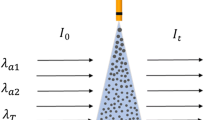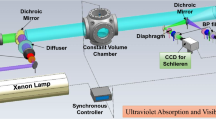Abstract
A three-color imaging technique was proposed for simultaneous measurements on distributions of fuel/air mixture temperature and fuel vapor/liquid concentrations in evaporating sprays. The idea is based on that the vapor concentration is proportional to the absorption of vapor to UV light, the liquid-phase concentration is related to the light extinction due to scattering of droplet to visible light, and the mixture temperature can be correlated to the absorbance ratio at two absorbing wavelengths or narrow bands. For verifying the imaging system, the molar absorption coefficients of p-xylene at the three narrow bands, which were centered respectively at 265, 289, and 532 nm with FWHM of 10 nm, were measured in a specially designed calibration chamber at different temperatures (423–606 K) and pressure of 3.6 bar. It was found that the ratio of the molar absorption coefficients of p-xylene at the two narrow bands centered at the two UV wavelengths is sensitive to the mixture temperature. On the other hand, the distributions of fuel vapor/liquid concentrations can be obtained by use of absorbance due to ultraviolet absorption of vapor and visible light scattering of droplets. Combining these two methods, a simultaneous measurement on distributions of mixture temperature and fuel vapor/liquid concentrations can be realized. In addition, the temperature field obtained from the ratio of the two absorbing narrow bands can be further used to improve the measurement accuracy of vapor/liquid concentrations, because the absorption coefficients depend on temperature. This diagnostic was applied to an evaporating spray inside a high-temperature and high-pressure constant volume chamber.













Similar content being viewed by others
References
Beyrau F, Bräuer A, Seeger T, Leipertz A (2004) Gas-phase temperature measurement in the vaporizing spray of a gasoline direct-injection injector by use of pure rotational coherent anti-Stokes Raman scattering. Opt Lett 29(3):247–249
Düwel I, Koban W, Zimmermann FP, Dreier T, Schulz C (2009) Spectroscopic characterization of the fluorobenzene/DEMA tracer system for laser-induced exciplex fluorescence for the quantitative study of evaporating fuel sprays. Appl Phys B 97:909–918
Einecke S, Schulz C, Sick V (2000) Measurement of temperature, fuel concentration and equivalence ratio fields using tracer LIF in IC engine combustion. Appl Phys B 71:717–723
Faust S, Goschütz M, Kaiser SA, Dreier T, Schulz C (2014) A comparison of selected organic tracers for quantitative scalar imaging in the gas phase via laser-induced fluorescence. Appl Phys B 117:183–194
Fujimoto H, Choi D, Shima Y, Senda J (2002) Two-dimensional imaging of fuel-vapour concentration by use of LIEF technique during mixture formation process in a DI diesel engine. Meas Sci Technol 13:391
Gumprecht RO, Sliepcevich CM (1953) Scattering of light by large spherical particles. J Phys Chem 57(1):90–95
Hammond DC (1981) Deconvolution technique for line-of-sight optical scattering measurements in axisymmetric sprays. Appl Opt 20(3):493–499
Kamimoto T, Yokota H, Kobayashi H (1989) A new technique for the measurement of Sauter mean diameter of droplets in unsteady dense sprays. SAE Technical Paper, p 890316
Lind S, Retzer U, Will S, Zigan L (2017) Investigation of mixture formation in a diesel spray by tracer-based laser-induced fluorescence using 1-methylnaphthalene. Proc Combust Inst 36:4497–4504
Löffler M, Beyrau F, Leipertz A (2010) Acetone laser-induced fluorescence behavior for the simultaneous quantification of temperature and residual gas distribution in fired spark-ignition engines. Appl Opt 49:37–49
Melton LA (1983) Spectrally separated fluorescence emissions for diesel fuel droplets and vapor. Appl Opt 22:2224–2226
Senda J, Kanda T, Kobayashi M, Fujimoto H (1997) Quantitative analysis of fuel vapor concentration in diesel spray by exciplex fluorescence method. SAE Technical Paper, p 970796
Suzuki M, Nishida K, Hiroyasu H (1993) Simultaneous concentration measurement of vapor and liquid in an evaporating diesel spray. SAE Technical Paper, p 930863
Thurber M, Hanson R (2001) Simultaneous imaging of temperature and mole fraction using acetone planar laser-induced fluorescence. Exp Fluids 30:93–101
Wang Q, Zhang Y (2017) Fluorescence and absorption characteristics of p‑xylene: applicability for temperature measurements. Appl Phys B 123:242
Westlye FR, Penney K, Ivarsson A et al (2017) Diffuse back-illumination setup for high temporally resolved extinction imaging. Appl Opt 56(17):5028
Zhang Y (2001) A study on mixture formation in diesel sprays with split injection strategy. Doctor degree dissertation, Hiroshima University, Japan
Zhang Y, Yoshizaki T, Nishida K (2000) Imaging of droplets and vapor distributions in a diesel fuel spray by means of a laser absorption–scattering technique. Appl Opt 39:6221–6229
Zhang Y, Kotani Y, Yoshida A et al (2007) A challenge to vapor distribution measurement of multi-component evaporating fuel spray via laser absorption-scattering (LAS) technique. Combust Sci Technol 179(5):863–881
Zigan L, Trost J, Leipertz A (2014) Visualisation of temperature and vapour distribution in a gasoline spray. MTZ Worldw 75:50–55
Zigan L, Trost J, Leipertz A (2016) Simultaneous imaging of fuel vapor mass fraction and gas-phase temperature inside gasoline sprays using two-line excitation tracer planar laser-induced fluorescence. Appl Opt 55:1453–1460
Acknowledgements
The research was sponsored by National Natural Science Foundation of China (no. 91741130) and Intergovernmental international cooperation in science and technology innovation (no. 2016YFE0127500).
Author information
Authors and Affiliations
Corresponding author
Rights and permissions
About this article
Cite this article
Qi, W., Zhang, Y. A three-color absorption/scattering imaging technique for simultaneous measurements on distributions of temperature and fuel concentration in a spray. Exp Fluids 59, 70 (2018). https://doi.org/10.1007/s00348-018-2525-0
Received:
Revised:
Accepted:
Published:
DOI: https://doi.org/10.1007/s00348-018-2525-0




